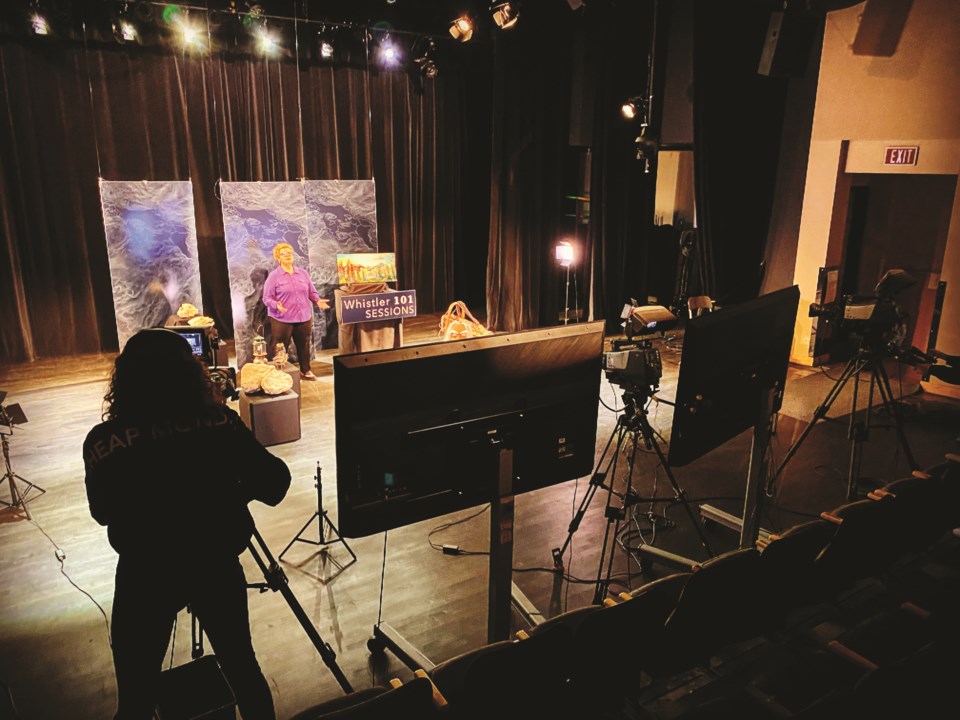The first thing I realized working on Whistler 101—the five-episode video series produced by the RMOW in collaboration with the Squamish Lil’wat Cultural Centre, Whistler Museum, Whistler Naturalists, and Arts Whistler—was how much there was to learn about this place. Whether concerning Whistler’s physical environment, biological abundance, those who hunted and gathered here for millennia, recent arrivals who turned it into a toursitc titan, or the creative endeavours of all, there’s no shortage of fodder for the mind: from fundamentals to esoterica, from big ideas to trivia, and plenty of—as ’90s talk-show host Arsenio Hall used to opine—things that make you go Hmmm…
A community celebration, the series utilizes local knowledge to explore five diverse—but interconnected—topics: Geodiversity, Biodiversity, Indigenous Peoples, History & Heritage, and The Arts. Spearheaded by RMOW Manager of Cultural Planning and Development John Rae, who developed the program’s vision, the series aims to instill a sense of belonging, as well as a responsibility to our surroundings, our neighbours, our history, and our ways of expression. Rae’s hope is that the series not only raises community awareness, knowledge and enthusiasm, but also inculcates an ambassadorial will to share notions of stewardship with visitors.
The series of in-person TED Talk-meets-slideshows would have launched last April at Maury Young Arts Centre, but the pandemic scuttled plans for in-person events indefinitely, resulting in a total revamp to a digital format. Having worked on developing the original versions, I took on responsibility to condense the hour-long presentations into 15-20-minute videos and direct the filming. Knee-deep in helping presenters package their topics, I quickly realized how much information there was to cull. On the other hand, Whistler 101 was never meant to be comprehensive, only informative and entertaining to the point of stimulating the curiosity of viewers who wanted to know more. Like, say, putting up a billboard over a rabbit-hole. With the hard work of presenters, and top-notch post-production by the team at Switchback Entertainment bringing a consistent look and polish to the visual end, the job was a pleasure filled with fascinating revelations.
Keeping to the connectedness theme, episodes were released in a logical order such that each underpinned the next, beginning with the unfathomable sweep of deep time to more recent pursuits: Geodiversity; Biodiversity; Indigenous Peoples; History & Heritage; The Arts can be read as the land, the life it supports, first human inhabitants, colonists, how all interpret the land and our place in it.
Connectedness isn’t a new idea. The concept of geodiversity being linked to biodiversity, for instance, goes back to German naturalist and explorer Alexander von Humboldt. “The philosophical study of nature endeavors to connect the present with the past,” he wrote in his 1858 epic, Cosmos: A Sketch of the Physical Description of the Universe. “In considering physical phenomena… we find its noblest and most important result to be a knowledge of the chain of connection, by which all natural forces are linked together, and made mutually dependent upon each other.”
Alex was contemporary to Charles Darwin, who also banged the interconnectedness drum, channeling early geologist Charles Lyell’s “Uniformitarianism”—the controversial notion that laws and processes behind geological phenomena have been the same throughout time. In other words, Lyell viewed Earth’s history as vast and directionless, a complimentary overview uploaded by Darwin to his nascent theory of biological evolution. Echoing this, the episodes take an inverted pyramid approach, starting with a very wide-angle view before narrowing to local context.
I learned plenty from each, whether about geohazard research at Mt. Meager (Geodiversity), or the Valley, Snow Zone and No-snow Zones that define where things live on our mountains (Biodioversity). With Indigenous Peoples, my revelations deepened to seeing the wide view of contemporary Indigenous life through two lenses—the profound diversity of First Nations communities and cultures across Canada and in B.C., and ongoing intergenerational trauma resulting from colonial history—in particular the legacy of Residential Schools. These are two crucial contexts to absorb before considering the traditions of the Squamish Nation and Lil’wat Nation and their unique shared territory in which Whistler lies. As per oral history, an ancient sharing agreement basically stated that when you could see Black Tusk you knew you were in a shared territory… but when the water changed directions you were in someone else’s. It wasn’t lost on me that this was a geological premise, based both on the glacio-volcanic feature of the Black Tusk (t’ak’t’ak mu’yin tl’a in7in’a’xe7en in the Squamish language, “Landing Place of the Thunderbird”) and the unique hydrology of Whistler; its chain of lakes, remnants of glacial-scoured meltwater basins, originally flowed both north and south from Alta Lake. As we learn in the video, Spo7ez, a shared trading village that once existed near the junction of Rubble Creek and the Cheakamus River, is at the core of why the Squamish Lil’wat Cultural Centre exists under a more contemporary agreement.
The Pemberton Trail, a first formal incursion by colonial settlers, followed First Nations trading routes from Howe Sound to Lillooet in hopes of finding a better way to the goldfields (geology again!) of the Interior. When that didn’t pan out (ha ha) it was thought cattle might be driven down it from the Interior to the sea. The trail of course, proved too rough for such folly, but the sprinkling of hunters and fishers who lodged along the trail to avail themselves of the valley’s biodiverse resources would be responsible—along with the arrival of a railway and logging—for Whistler’s eventual appeal as a townsite and tourist destination. An identity originally based around the draw of lakes that later turned to the peaks with an attendant effect on local art—not only a circling back to deep time, but something that genuinely makes you go Hmmm…
You can check out the series here: whistler.ca/culture-recreation/arts-nature-heritage/whistler-heritage/Whistler-101.
Leslie Anthony is a biologist, writer and author of several popular books on environmental science.


